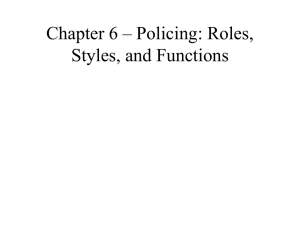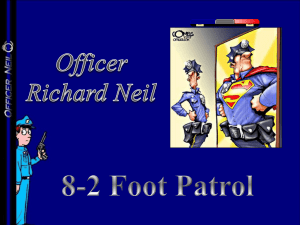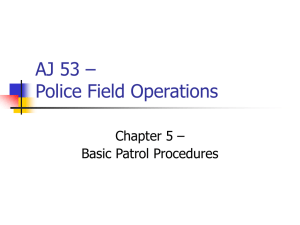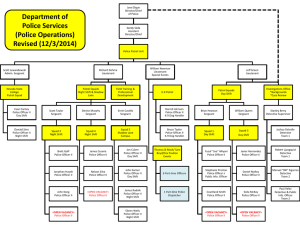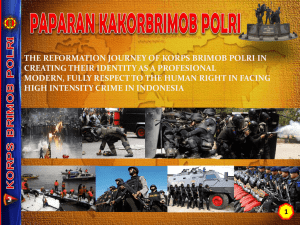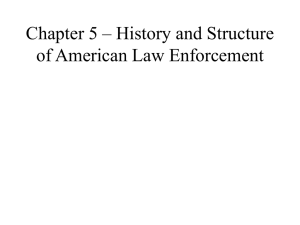Clarendon Hills-Hinsdale Police Consolidation Study - E
advertisement
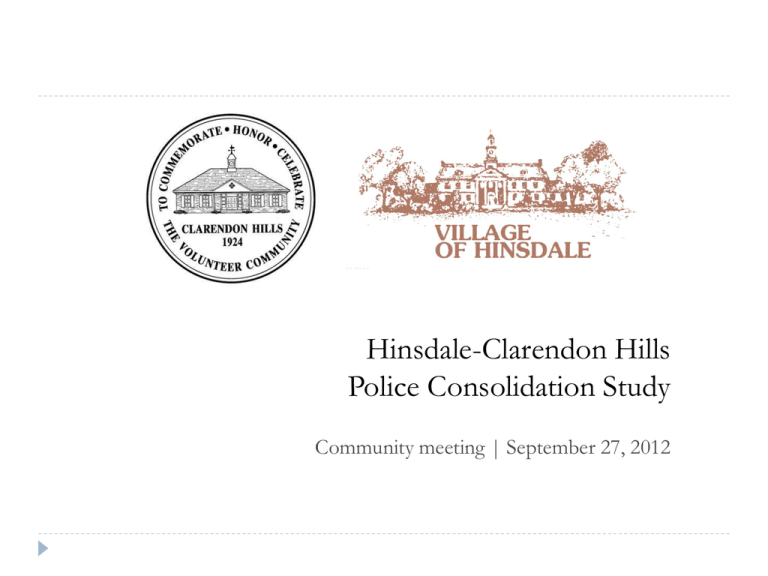
Hinsdale-Clarendon Hills Police Consolidation Study Community meeting | September 27, 2012 Agenda Introduction How the discussion started Why consolidation? What a consolidated department would look like Potential cost savings of a new department Next Steps Agenda If you have a question before, during, or after the presentation, please raise your hand and a staff person will bring you a note card. The note cards will be read aloud by a presenter to the audience and responded to during the Question and Answer Session after the presentation. We will not be taking verbal questions. After the meeting all of the questions we receive and our responses will be put on our website so residents who could not attend the meeting can have access to the information Why Look at Consolidation? How the Process Started In summer of 2009, Hinsdale invited Village Presidents and Managers of surrounding communities to a meeting to discuss possibilities of shared services. Consensus was to focus on Police Services as this is our largest budget item in all municipalities. Municipalities established basis for shared services/consolidation Cost control Maintain High Service Levels Maintain Local Control Equal Representation in Governance The 4 municipalities continued to work on a shared service plan through April 2011. Why look at Consolidation? To allow for an implementation of a plan, in April 2010 Hinsdale moved its dispatching to SWCD, so all municipalities were on the same communications system. In May 2011 the CH Police Chief resigned which prompted Hinsdale and Clarendon Hills officials to consider a shared service model between the 2 communities (similar to our Fire Services Agreement). In summer 2011, the Police Chiefs explored the potential for a shared service model between the 2 communities and recommended a consolidation model that would produce substantial savings for both communities. In October 2011 the 2 Villages publically announced that they were engaged in discussions regarding the possible consolidation of the 2 Police Departments. In January 2012, the 2 Villages received a grant from the ICJIA for phase 1 to aid in the consolidation process. During 2012 the Villages have continued to define the model which will be explained by the Chiefs. Hinsdale Organizational Chart Chief of Police Deputy Chief Operations Deputy Chief Administration Patrol Shift #1 Days Patrol Shift #2 Nights Patrol Shift #3 Days Patrol Shift #4 Nights Sergeant Sergeant Sergeant Sergeant Patrol Officers Patrol Officers Patrol Officers Patrol Officers Power Shift Officer Investigations Det. Sergeant Investigators 1 FT Juvenile Officer School Resource Officer 25 Sworn Officers Authorized 24 Sworn Officers Currently Crime Prevention Dare Officer Clarendon Hills Organizational Chart Chief of Police Deputy Chief Vacant Sergeant Detective (1) Patrol Officers (2) Sergeant Vacant Patrol Officers (3) Patrol Officers (3) 14 Sworn Officers-Authorized 13 Sworn Officers-Currently Calls for Service by Time of Day Comparison Jan 1 2012 thru July 31, 2012 Calls for Service by Day of Week Comparison Jan 1, 2012 to July 31, 2012 Today’s Patrol Staffing Levels Hinsdale 12 hour shift schedule 6 am to 6 pm and 6 pm to 6 am 1 Sergeant 3 Patrol officers shift Additional Power Shift Clarendon Hills Wednesday thru Saturday 4 pm to 2 am Total Patrol Staffing: As many as 5 officers and not less than 3 officers. 8 hour shift schedule 7 am to 3 pm, 3 pm to 11pm and 11 pm to 7 am 1 Sergeant 2 Patrol officers. Total Patrol Staffing: As many as 3 officers and not less than 2 officers. Consolidated Patrol Staffing Patrol Officers work 12 hour shifts 1 Sergeant 5 Patrol Officers Power Shift Tuesday through Saturday 4 pm to 2 am. 1 Patrol Officer As many as 7 officers working but not less than 5 officers at any time. Consolidated Police Department Organizational Chart Total authorized sworn prior to consolidation 39. Following consolidation 34. Police Chief Deputy Chief Administration Investigations Sergeant 3 Investigators 1 School Resource Officer School Liaison Officer/Crime Prevention -1 Police Chief Deputy Chief Operations Patrol Sergeant Days 5 Patrol Officers Patrol Sergeant Days 5 Patrol Officers Patrol Sergeant Nights 5 Patrol Officers -1 Deputy Chief Patrol Sergeant Nights 5 Patrol Officers Positions Reduced: 1 Chief 1 Deputy Chief 3 Sergeants Power Shift -3 1 Officer Sergeant Standardization Process and Training Consolidating agencies requires standardization of practices that includes: Policies and Procedures Reporting and documentation Evidence collection Equipment such as mobile video recording systems. Training Policies and Procedures Ordinances Geography Organizational Structure, Processes, Lines of Authority Village Practices HR related issues Consolidation Efficiencies No change in police response times. May actually result in improved response times. Increased staffing during simultaneous calls for service for each community. Increase investigatory resources. Supervisory span of control will be 1:6 Increased efficiency in specialized units. Reduced redundancy in administrative positions. Governance of New Department Intergovernmental Agreement Defines organizational relationships Defines financial obligations Determines processes for the resolution of conflicts Provides for the dissolution of a consolidated department, if desired Provides for an equal partnership between two “sovereign” entities Not a new unit of government- new department would have to compete for resources and be subject to community oversight just as today. Governance of New Department Current Model Chief of Police Reports to Village Manager Village Manager Chief of Police Police Department Staff Proposed Model Chief of Police Reports to Joint Law Enforcement Committee Joint Law Enforcement Committee Chief of Police Police Department Staff Governance of New Department Joint Law Enforcement Committee Would meet in sessions open to the public 6 members: Village Presidents (from each community) Village Trustee Representatives (from each community) Village Managers (from each community) Rotating Chairmanship Tie votes or disputes resolved via a previously agreed upon arbitrator Oversee departmental budget, overall direction and department standards, and supervision of the Chief of Police Most decisions made at Chief of Police level, just as today Village Managers would still provide for day-to-day coordination between joint police department and other Village departments with the Chief of Police Governance of New Department Consolidated Board of Police Commissioners Similar to current Boards of Police and Fire Commissioners Representatives of each community appointed by the Village Presidents Oversee the testing processes for new hires and promotions, as well as discipline Currently 3 member Board of Police and Fire Commissioners in each community. Would have a merged commission that would handle police issues only Make up of committee still to be determined Governance of New Department Pension Fund Board Under state law: current board has 2 active employees, 1 retiree, 2 village president appointees New board would have same make-up under law, with each Village President appointing one-at-large member and the other members elected by pension participants Cost Savings Estimates of Merged Department? Annual Combined Cost Savings Estimate of $700,000 to $800,000 depending on various factors including: Timing of attrition based staffing reductions to 34 total sworn officers Which personnel retire Cost Savings Estimate does not include any potential savings from reduction in capital equipment or facilities. Current plan is to initially keep both facilities operating as normal. Cost Sharing of the Savings between the communities will be based on a model that would include a combination of population and call volume. As a result of the consolidation, a combined Pension Fund would be created. Municipalities would retain current liabilities Municipalities would share proportionately future liabilities Costs would be actuarially determined Actuarial Assumptions would need to be adjusted to match Next Steps Further revision of financial model and Intergovernmental Agreement (ongoing) Further development and presentation of a bill in Springfield to remove legal barriers to consolidation (November, 2012) Union negotiations with employees (Current contracts expire April 30, 2013) Further Public input and decision by Village Boards to proceed with discussion and merger (December, 2012) Implementation 10 Minute Break Questions and Answers


